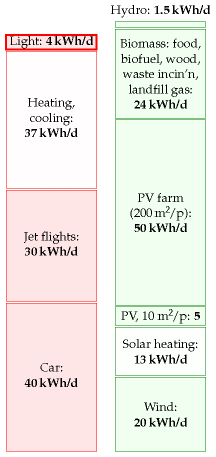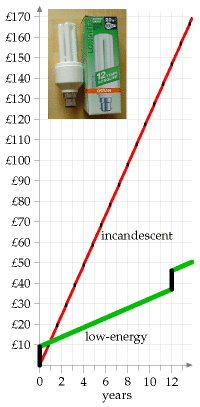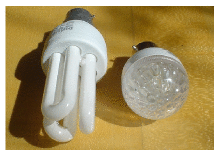
9 Light
Lighting home and work
The brightest domestic lightbulbs use 250 W, and bedside lamps use 40 W. In an old-fashioned incandescent bulb, most of this power gets turned into heat, rather than light. A fluorescent tube can produce an equal amount of light using one quarter of the power of an incandescent bulb.
| Device | Power | Time per day | Energy per day per home |
|---|---|---|---|
| 10 incandescent lights | 1 kW | 5 h | 5 kWh |
| 10 low-energy lights | 0.1 kW | 5 h | 0.5 kWh |
How much power does a moderately affluent person use for lighting? My rough estimate, based on table 9.2, is that a typical two-person home with a mix of low-energy and high-energy bulbs uses about 5.5 kWh per day, or 2.7 kWh per day per person. I assume that each person also has a workplace where they share similar illumination with their colleagues; guessing that the workplace uses 1.3 kWh/d per person, we get a round figure of 4 kWh/d per person.
Street-lights and traffic lights
Do we need to include public lighting too, to get an accurate estimate, or do home and work dominate the lighting budget? Street-lights in fact use about 0.1 kWh per day per person, 1 and traffic lights only 0.005 kWh/d per person 2 – both negligible, compared with our home and workplace lighting. What about other forms of public lighting – illuminated signs and bollards, for example? There are fewer of them than street-lights; 3 and street-lights already came in well under our radar, so we don’t need to modify our overall estimate of 4 kWh/d per person.
Lights on the traffic

In some countries, drivers must switch their lights on whenever their car is moving. How does the extra power required by that policy compare with the power already being used to trundle the car around? Let’s say the car has four incandescent lights totalling 100 W. The electricity for those bulbs is supplied by a 25%-efficient engine powering a 55%-efficient generator, 4 so the power required is 730 W. For comparison, a typical car going at an average speed of 50 km/h and consuming one litre per 12 km has an average power consumption of 42 000W. So having the lights on while driving requires 2% extra power.
What about the future’s electric cars? The power consumption of a typical electric car is about 5000 W. So popping on an extra 100 W would increase its consumption by 2%. Power consumption would be smaller if we switched all car lights to light-emitting diodes, but if we pay any more attention to this topic, we will be coming down with a severe case of every-little-helps-ism.
The economics of low-energy bulbs
Generally I avoid discussing economics, but I’d like to make an exception for lightbulbs. Osram’s 20 W low-energy bulb claims the same light output as a 100 W incandescent bulb. Moreover, its lifetime is said to be 15 000 hours (or “12 years,” at 3 hours per day). In contrast a typical incandescent bulb might last 1000 hours. So during a 12-year period, you have this choice (figure 9.3): buy 15 incandescent bulbs and 1500 kWh of electricity (which costs roughly £150); or buy one low-energy bulb and 300 kWh of electricity (which costs roughly £30).
Should I wait until the old bulb dies before replacing it?
It feels like a waste, doesn’t it? Someone put resources into making the old incandescent lightbulb; shouldn’t we cash in that original investment by using the bulb until it’s worn out? But the economic answer is clear: continuing to use an old lightbulb is throwing good money after bad. If you can find a satisfactory low-energy replacement, replace the old bulb now.
What about the mercury in compact fluorescent lights? Are LED bulbs better than fluorescents?

Researchers say that LED (light-emitting diode) bulbs will soon be even more energy-efficient than compact fluorescent lights. The efficiency of a light is measured in lumens per watt. I checked the numbers on my latest purchases: the Philips Genie 11 W compact fluorescent bulb (figure 9.4) has a brightness of 600 lumens, which is an efficiency of 55 lumens per watt; regular incandescent bulbs deliver 10 lumens per watt; the Omicron 1.3 W lamp, which has 20 white LEDs hiding inside it, has a brightness of 46 lumens, which is an efficiency of 35 lumens per watt. So this LED bulb is almost as efficient as the fluorescent bulb. The LED industry still has a little catching up to do. In its favour, the LED bulb has a life of 50 000 hours, eight times the life of the fluorescent bulb. As I write, I see that www.cree.com is selling LEDs with a power of 100 lumens per watt. It’s projected that in the future, white LEDs will have an efficiency of over 150 lumens per watt [ynjzej]. I expect that within another couple of years, the best advice, from the point of view of both energy efficiency and avoiding mercury pollution, will be to use LED bulbs.
Mythconceptions
“There is no point in my switching to energy-saving lights. The “wasted” energy they put out heats my home, so it’s not wasted.”
This myth is addressed in Chapter 11.
| Bulb type | efficiency (lumens/W) |
|---|---|
| incandescent | 10 |
| halogen | 16-24 |
| white LED | 35 |
| compact fluorescent | 55 |
| large fluorescent | 94 |
| sodium street light | 150 |
Notes and further reading
page no.
- Street-lights use about 0.1 kWh per day per person… There’s roughly one sodium street-light per 10 people; each light has a power of 100 W, switched on for 10 hours per day. That’s 0.1 kWh per day per person.↩
- … and traffic lights only 0.005 kWh/d per person. Britain has 420 000 traffic and pedestrian signal light bulbs, consuming 100 million kWh of electricity per year. Shared between 60 million people, 100 million kWh per year is 0.005 kWh/d per person.↩
- There are fewer signs and illuminated bollards than street-lights. [www.highwayelectrical.org.uk]. There are 7.7 million lighting units (street lighting, illuminated signs and bollards) in the UK. Of these, roughly 7 million are street-lights and 1 million are illuminated road signs. There are 210 000 traffic signals. According to DUKES 2005, the total power for public lighting is 2095 GWh/y, which is 0.1 kWh/d per person.↩
- 55%-efficient generator – source: en.wikipedia.org/wiki/Alternator. Generators in power stations are much more efficient at converting mechanical work to electricity.↩